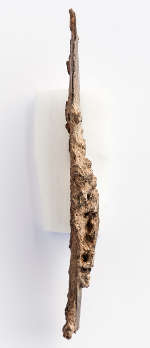River subbasins more depleted than
official figures show
09 April 2024
Published online 4 October 2018
A well-preserved tool found in a Moroccan cave suggests that unique bone implements were used by the Aterian culture over 90,000 years ago.

Mohammed Kamal, Fotokam, Morocco
Enlarge image
Abdeljalil Bouzouggar at the Institut National des Sciences de l’Archéologie et du Patrimoine in Rabat, Morocco, together with a team of scientists from the UK, Germany and France, conducted several archaeological digs at the Dar Es-Soltan 1 cave on the Atlantic Coast of Morocco from 2005 to 2012. During their last dig, they uncovered a precisely made bone tool, measuring 122 millimetres in length, in a sedimentary layer dating to around 90,000 years ago. The age of the find links the tool to the Aterian culture, a Middle Stone Age people known for their stone-tool technologies.
“Much attention has been focused on the narrow issue of stone tool use by Palaeolithic human groups, rather than considering a wider set of other tools,” says Bouzouggar. “When we discovered this tool, understanding its manufacture and function became just as important as a reliable dating.”
The researchers used various analytical techniques to unravel the story of the tool and how it was made. Using a scanning electron microscope, they analysed modifications on the surface of the bone, including cut marks, flaking and polishing marks. They also recorded the tool’s three-dimensional surface topography using CT scanning.
The tool was made from the rib bone of a large mammal (likely the bovid family), which was first shortened and split into two lengthwise. The toolmaker then deliberately straightened its sides, before thinning and sharpening one side at one end by scraping it with a stone tool. The team’s analysis was so detailed that they found ‘chatter marks’ created by the pressure applied to the stone as it juddered across the bone’s surface. The researchers believe the tool was used as a knife held with two fingers on the smooth side to push down with the sharpened edge and cut soft objects.
“The proximity of the cave site to the sea suggests that the knife may have been used for cutting fish,” says Bouzouggar. “However, we will need to investigate further since this is the first tentative indication of marine resource exploitation by Aterians.”
doi:10.1038/nmiddleeast.2018.123
Bouzouggar, A. et al. 90,000 year-old specialised bone technology in the Aterian Middle Stone Age of North Africa. PLOS One 13 (10) (2018).
Stay connected: